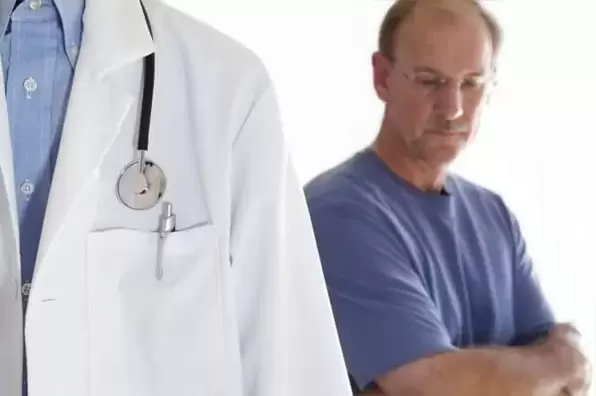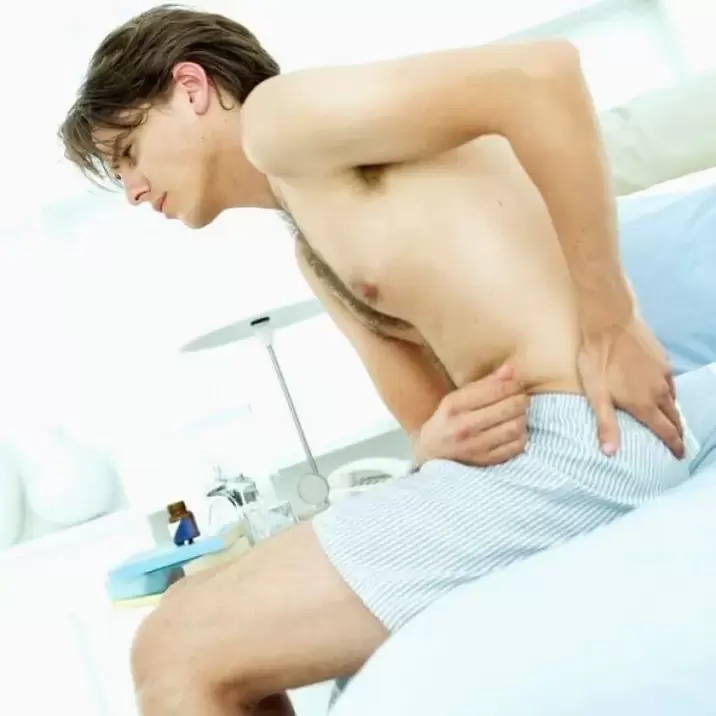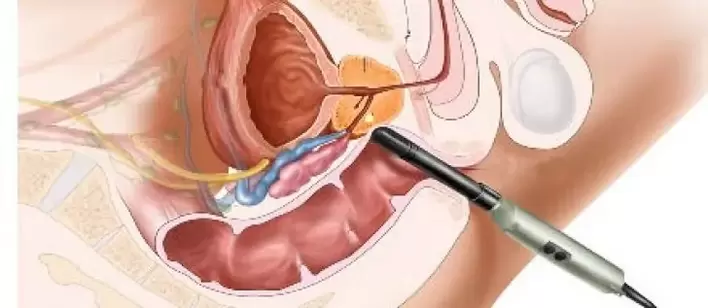
Chronic prostatitis is a serious problem. Even modern urology cannot answer many questions related to this pathology. Experts believe that chronic prostatitis is a disease that results from a variety of health problems, including tissue damage, as well as dysfunction not only of the urinary tract and prostate but also of the prostate. and other agencies.
The disease is diagnosed mainly in men of reproductive age. In older men, chronic prostatitis is often accompanied by benign tumors of the prostate gland.
Classification of diseases
The classification of prostatitis was developed by scientists at the US National Institutes of Health in 1995:
%20and%20chronic%20prostatitis%20(right).webp)
- 1 Category- acute bacterial prostatitis. It is diagnosed in 5% of cases with prostatitis.
- type 2- chronic bacterial prostatitis.
- 3 types- chronic bacterial prostatitis. This pathology has another name - chronic pelvic pain syndrome.
- Type 3A- an inflammatory form of chronic prostatitis. It is diagnosed in 60% of chronic prostatitis cases.
- Type 3B- non-inflammatory form of chronic prostatitis. Diagnosed in 30% of cases.
- 4 types- asymptomatic prostatitis.
There is also a classification of chronic prostatitis, compiled in 1990.
Symptoms of Chronic Prostatitis
Discomfort and pain in the pelvic area that persists for more than 3 months are the main symptoms of chronic prostatitis.
In addition, urinary disorders and erectile dysfunction are observed:
- The pain occurs in the perineum and may radiate to the anus, groin, inner thighs, sacrum, lower back, and scrotum. Pain on one side, extending to the testicle, is not usually a symptom of chronic prostatitis;
- erection does not occur, despite adequate conditions, but complete impotence is not observed;
- in the early stages of the development of the disease, premature ejaculation is observed;
- frequent urination, urinary incontinence, pain and burning sensation during bladder emptying.
The clinical picture may vary depending on the type of chronic prostatitis.
infectious form:
- urinating a lot at night;
- pain in the thighs, perineum, glans penis, and rectum, which gets worse with movement;
- painful urination;
- weak urine stream.
Specific infections:
- mucus discharge from the urethra;
- the above symptoms.
Non-infectious prostatitis:
- acute pain in the perineum;
- pain in the thighs and head of the penis;
- pain increases when forced to interrupt sex or not have a prolonged intimate life.
Importance!The disease progresses in stages. Symptoms may weaken or intensify, but their presence clearly indicates the presence of an inflammatory process.
Symptoms can vary depending on the stage of development of the disease.

The following stages of development of the pathology are distinguished:
- Save. The patient feels pain in the pubic, groin and scrotum. Frequent urination and discomfort after intercourse. Erections can be painful.
- Replace.The pain is more intense, localized to the groin, pubic area and to the sacrum. Urination is accelerated, but not difficult. Erection is not.
- Increase birth.During an exacerbation, urination becomes more frequent. Urine flow becomes weak.
- Emoticon.Sclerosis of prostate tissue occurs. There is a feeling of heaviness in the sacrum and pubic region. Increased urination. The erection becomes weaker. Ejaculation may be completely absent.
Symptoms can vary depending on the course of the disease, but in all cases, they will increase gradually.
Causes of chronic prostatitis
There are many factors that lead to chronic prostatitis. The disease occurs under the influence of infectious agents. Patients with hormonal, neurological, immunological and hemodynamic disorders. Biochemical factors, regurgitation of urine into the lobes of the prostate and impaired function of growth factors, which cause proliferation of living cells, affect.
Reasons that affect the pathogenesis:
- infections of the genitourinary system;
- lower motivation;
- irregular sex life;
- continuous bladder catheterization;
- frequent hypothermia.
Evolutiondisease of a bacterial naturepromote intravesical reflux.
Chronic bacterial prostatitisdevelops against the background of neurological disorders of the pelvic floor muscles, as well as the factors responsible for the functioning of the bladder wall, prostate gland and urethra.
The making progressmyofascial trigger points, located near the organs of the genitourinary system and prostate gland, can cause pelvic pain syndrome. Spots are the result of a number of diseases, surgical interventions, and trauma that can cause pain in the pubic region, perineum, and surrounding areas.
Diagnosis of disease
The presence of a wide range of symptoms makes diagnosing chronic prostatitis without much difficulty. However, in some cases, the disease may be asymptomatic. In this case, in addition to the standard examination and questioning of the patient, additional research methods are required.Neurological examination and study of the patient's immunological status are mandatory..
Importance!Special questionnaires and questionnaires allow you to more accurately determine the patient's subjective feelings and get a complete picture of health status, pain intensity, ejaculation, erection and urinary disorders. convenient.
Diagnostics in the laboratory
Laboratory diagnostics makes it possible to distinguish between a bacterial and a bacterial form of the disease, as well as identify the type of pathogen and provide the most accurate diagnosis.Chronic prostatitis is confirmed when a urine sample or fourth prostate secretion contains more than 10 leukocytes in the PZ, or bacterial associations.When the white blood cell count increases, but the bacteria are not seeded, the material is tested for chlamydia or other STD pathogens.
- The discharge from the urethra is sent to a laboratory to detect viruses, fungi and bacteria, white blood cells, and mucus in them.
- Urethral curettage was examined by PCR. This allows you to identify sexually transmitted pathogens.
- Microscopic examination of the secretory prostate is performed to count macrophages, leukocytes, amyloid bodies, and Trousseau-Lallemand bodies. An immunological study and a bacteriological study are prescribed. Determine the level of nonspecific antibodies.
- A blood sample was taken ten days after the digital rectal exam to determine the PSA concentration in it. At a rate above 4. 0 ng/ml, the patient underwent a prostate biopsy to rule out cancer.
Diagnosis is made on the basis of the results of studies.
Diagnostic tool

To clarify the stage and form of the disease will help transrectal ultrasound of the gland. Ultrasound allows you to exclude other diagnoses, monitor the effectiveness of treatment, as well as determine the size of the prostate gland, echogenic structure, uniformity and density of the seminal vesicles. Urodynamic and mapping studies of the pelvic floor muscles will allow to reveal the infrastructural obstruction and neurological disorders that often accompany the pathology.
X-rays and MRIs are used for differential diagnosis, especially with prostate cancer. These methods will reveal violations in the pelvic organs and spine.
Differential diagnosis
The differential diagnosis is important, as there is a risk that the patient will develop a more serious illness.
The differential diagnosis is established with the following diseases:
- pseudo-pain, dysfunction of the sphincter system, bladder dysfunction of neurological origin, complex regional pain syndrome;
- bladder tightening, hypertrophic changes in the bladder neck, prostate tumor;
- pubic osteoarthritis, cystitis;
- pathology of the rectum.
If symptoms occur, the prostate should be examined by a urologist or urologist. . Go for an ultrasound. If necessary, a prostate biopsy is prescribed.
Pathological treatment methods
Chronic prostatitis treated by a urologist or urologist. Therapy is carried out in a complex manner. Adjustment depends on the patient's lifestyle, thinking characteristics, and habits. The important thing is to move more, reduce alcohol consumption, get rid of nicotine addiction, eat right, and normalize your sex life. However, to do without a course of basic therapy will not be effective. Medication is the main condition for a full recovery.
Indications for hospitalization
Usually, treatment is done on an outpatient basis. But in case the disease does not go away and tends to recur, the patient is transferred to the hospital for more effective treatment.
Medical treatments
This method is aimed at eliminating the existing infection, normalizing blood circulation, improving the drainage of the prostate lobes, correcting the hormonal background and immune status. Therefore, the doctor prescribes antibiotics, vasodilators, immunomodulators, anticholinergics, and anti-inflammatory drugs.
If the pathology is bacterial in nature, then antibiotics are definitely recommended. The agent is prescribed based on the results of bacterial cultures in prostatic secretions.This will make it possible to isolate the pathogen with subsequent determination of its sensitivity to a specific drug. With a methodical scheme, the treatment efficiency is more than 90%.
In the bacterial form, a short course of antibiotics is prescribed. It is only continued if the program gives positive results. The effectiveness of therapy is about 40%.
With chronic pelvic pain, the duration of antibiotics should not exceed one month. With active dynamics, treatment is continued for another month. If that doesn't work, the medication is replaced with another, possibly more effective, drug.
Antibacterial agents from the fluoroquinolone group are the main drugs for the treatment of pathologies.They are highly bioavailable, active against most gram-negative bacteria, ureaplasmas and chlamydia, which accumulate in the tissues of the prostate gland.
When treatment with fluoroquinolones is ineffective, penicillin may be prescribed.
Antibacterial drugs are used for preventive purposes.
After antibiotic treatment, blocker therapy is prescribed.This treatment strategy is effective for patients with persistent obstructive and bothersome symptoms.
If urinary incontinence and pain persist, tricyclic antidepressants can be prescribed to relieve pain.
With severe violations of urination, before starting treatment, a urodynamic study is performed and action is taken on the basis of the results obtained.
Non-drug therapy
Non-drug therapies can increase the concentration of antibacterial drugs in the tissues of the gland, but the dosage should not be exceeded.
For this purpose, the following methods are used:
- electrophoresis;
- Laser therapy;
- Electrophoresis;
- Microwave hyperthermia (applied rectally).
When applying the second method, the temperature is selected individually. The temperature set in the range of 39-40 degrees allows you to increase the concentration of drugs in the body, activate the immune system at the cellular level, eliminate bacteria, relieve congestion. Increasing the range to 40-45 degrees allows you to achieve pain relief and sclerotherapy.
Laser and magnetic therapy are used in combination. The effect is similar to the effect of the above methods, in addition, it also has the effect of stimulating internal organs.
Rectal massage is performed only when there are no contraindications.

Surgical method
Chronic prostatitis usually does not require surgery. No exception are complications that threaten the health and life of the patient. Modern surgical treatment allows the use of laparoscopic surgery. It is minimally invasive. Rehabilitation is faster and causes less damage to the body.
Surgical methods are indicated for:
- sclerosis of the prostate gland;
- prostate tumor;
- tuberous sclerosis;
- calcification in the prostate.
Importance!Surgery is contraindicated in the acute phase. Surgical treatment is prescribed by the surgeon based on the results of the study and the overall clinical picture.
Prognosis for chronic prostatitis
Doctors are wary of predicting the outcome of the disease. It is very rare to achieve complete recovery. Basically, chronic prostatitis will go into long-term remission. Symptoms disappear, urine output and blood return to normal. In order for chronic prostatitis not to get worse and not cause complications, it is necessary to follow all the recommendations of a specialist.

























